World Stamps
Thematica souvenir sheets feature unused designs of prolific stamp artist
By Larry Rosenblum
When we look at a postage stamp, we don’t see evidence of the long process involved in its creation. The design generally takes many months, sometimes years, before it is finalized.
Once in a while, we get a glimpse at the design process with alternate designs that were not used.
A series of show souvenir sheets distributed at Britain’s Thematica stamp exhibitions from 2002 to 2009 displayed examples of unused designs by designer Jeffery Matthews.
Connect with Linn’s Stamp News:
Sign up for our newsletter
Like us on Facebook
Follow us on Twitter
Matthews’ efforts for Royal Mail extend across more than four decades. He designed more than a dozen sets of commemoratives, starting with the United Nations 20th Anniversary set in 1965 (Scott 440-441).
Much of his work related to royal and heraldic themes. He also did substantial work on the Machins, including developing a new typeface and a comprehensive color palette.
Matthews was named a Member of the Most Excellent Order of the British Empire (MBE) in 2004 for his “services to graphic design, particularly postage stamps.”
The Thematica 2004 souvenir sheet shows early designs for the 1984 set marking the 500th anniversary of the College of Arms.
The college, founded in 1484 by Richard III, is the heraldic authority for most of Great Britain and the Commonwealth, with the main exception of Scotland, which has its own equivalent.
The college grants coats of arms and is responsible for related matters.
The images on the sheet show one approach that Matthews pursued. The designs picture a joust scene showing Henry VIII; messengers on horseback; the banner, helmet, shield, and coat of a knight; and two coats of arms.
Ultimately, another idea was used for the issued stamps (Scott 1040-1043). Matthews interpreted four different coats of arms so they fit in a similar area of space: the College of Arms (16 pence); Richard III (20½p), the earl marshal head of the college (28p), and the city of London (31p).
Two of the Thematica souvenir sheets involve the familiar Machin definitives that are approaching their 50th anniversary.
Arnold Machin, the sculptor who created the famous image of the queen and for whom the series is named, designed the original stamps. He was responsible for the typeface, colors, and arrangement, as well as the portrait.
Soon thereafter, it was necessary to extend the Machins to include designs for use in the major regions of Great Britain other than England: Isle of Man, Northern Ireland, Scotland, and Wales.
Regional stamps, which were sold in their respective areas but were valid throughout Britain, were first issued in 1958.
The precedent had been set for using symbols of each region on the stamps. The 2008 Thematica sheet shows Matthews’ preliminary designs for all four regions (left to right): the triskelion (three legs) and Celtic chain for Isle of Man; St. Andrew’s Cross and thistle for Scotland; the Red Hand of Ulster and flax flower for Northern Ireland; and a dragon and leek for Wales.
These symbols take up a large part of the left side of the stamps.
However, a simpler design was chosen. A single symbol for each region was located at the upper left of the stamp so that the value tablet could remain in its normal position at lower left.
The symbols used were a chained triskelion for the Isle of Man, the heraldic lion for Scotland, the dragon of Wales, and the Red Hand of Ulster in a six-pointed star under a crown for Northern Ireland.
Perhaps the most interesting of the Jeffery Matthews Thematica souvenir sheets is the first, from 2002. It pictures two stamps with the Machin head but in an unusual horizontal format. The text reads, “Conceptual ideas, created by Jeffery Matthews for the presentation of the Machin portrait on British definitives … ”
This modest text doesn’t give any indication of the story behind these designs. In the early 1980s, Matthews was involved in a project to develop a new, more current portrait of the queen to replace the one used on the Machins. After much work, it became known that the queen liked the Machin portrait and did not want it replaced.
Royal Mail then began efforts to see if the Machin head could be used in a new way to freshen the design that had been in use for almost 20 years. The horizontal stamps shown on the 2002 sheet were from this project.
Ultimately, though, the original Machin design was retained.
This experience was helpful to Matthews a few years later. Royal Mail began experimenting with self-adhesive stamps and wanted a Machin that could be easily spotted when used. Matthews developed horizontal Machins not much different from the ones on the sheet.
The horizontal stamps were used in a booklet in 1993 (Scott MH243a) and coils in 1997 (MH308-09). Once the experiments were complete, the traditional vertical design replaced the horizontal one.
MORE RELATED ARTICLES
Headlines
-
US Stamps
Oct 7, 2024, 3 PMMcMurtrie dismissed as APS education director following Sept. 21 arrest
-
US Stamps
Oct 7, 2024, 12 PMVasiliauskas named president of Mystic Stamp Co.
-
US Stamps
Oct 6, 2024, 5 PMApgar souvenir card available
-
US Stamps
Oct 6, 2024, 4 PMFirst Continental Congress and U.N. stamps receive Scott catalog numbers














